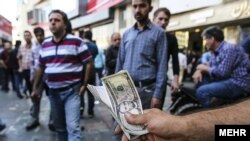Tehran’s prosecutor has announced that an additional “53 forex traders” have been arrested “in the last ten days”, in the ongoing currency crisis in Iran that has gripped the country for months.
Abbas Jafari Dolatabadi also said on October 23 that the Central Bank has poured $18.5 billion into the forex market from October 2017-March 2018, without much success in controlling the downward spiral of Iran’s national currency, the rial.
Iran’s oil export revenue through September 30 this year is estimated to be $55 billion. Therefore, spending $18.5 billion to support the forex market has taken a big chunk of Iran’s main currency earnings.
As President Donald Trump’s administration began threatening the reimpostion of sanctions on Iran at the beginning of the year, the rial started losing value and has depreciated almost five-fold on the open market since March.
In the past few weeks, Iranian authorities have announced the arrest of more than 1,000 forex traders. These are mostly people who buy and sell currencies on the streets.
Officially licensed traders have been allowed to buy and sell, after a period of ban on all fee market trading.
Iranian economists have repeatedly said that arresting traders can only have a short-term impact on maintaining or lowering exchange rates, but on a longer term such measures are doomed to fail, as pressure builds up among people to buy foreign currencies.
Iran currently has a three-tier forex system. The first tier is a low exchange rate for officially approved importers of essential and industrial goods, who get dollars at around 42,000 rials.
The secondary tier, is dollars brought back to the country by exporters and sold to licensed forex traders, who sell it back to merchants who need dollars for importing consumer and other goods. At this market each dollar buys 140,000 rials. The third tier is the free market for cash dollars, which now trades at a slightly higher rate than the second tier.
Before the 1979 revolution, the dollar was trading at 70 rials; an almost unimaginable difference of value compared to current rates.
The 18.5 billion dollars the prosecutor says was spent at the end of last year and the beginning of this year by the central bank was given to other banks to sell to businesses and individuals at the free market rates. Therefore, it was meant to directly prop up the rial. But the result was total failure, as the threat of U.S. sanctions accelerated the fall of the national currency.
Jafari Dolatabadi also blamed corruption and embezzlement for the financial problems the country faces.
In one instance, he described a case in which an individual bought a company in Khuzestan province three years ago and then received $800 million from banks, ostensibly to boost production and through exports to return the hard currency to the central bank. But he never repaid the dollars and now is on the run.
He did not name the individual but added that the central bank has given out $10 billion to individuals and companies in similar cases and most of it has been embezzled.
Iranian banks have huge uncollected debts, which eventually become a burden on the state, as there are no truly private banks in Iran. According to media reports and statements by officials, 80 percent of all uncollected debts to banks are owed by 500 debtors. It is widely assumed that these are well-connected and powerful individuals who are “untouchable”.





